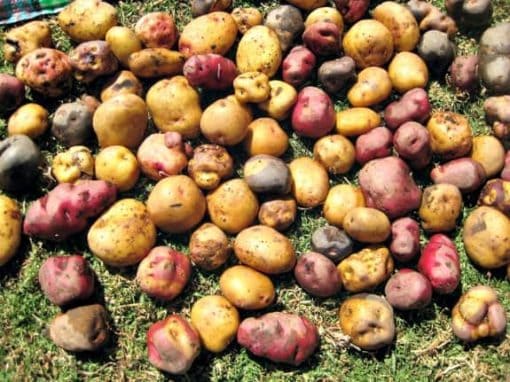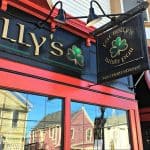Every October 5th, the Andean peoples of Peru celebrate the day of the Olluquito that signifies the importance of the From, one of 3,800 varieties of potato found in Peru and served at Rainforest Expeditions’ three eco-lodges deep in the Peruvian Amazon.
A leader in Peru’s sustainable tourism, Rainforest Expeditions is introducing farm-to-table to its jungle accommodations, including locally sourced foods such as Olluco. This will allow for menus to reflect the region’s indigenous and immigrant traditions, while offering such diverse bounty as abundant seafood from the coast, tropical fruits from the jungle and grains and potatoes endemic to the Andes. Historically, local cuisine has been overlaid with culinary influences from Europe, Africa and Asia, resulting in a colorful, richly textured table for all palates, including those favoring vegetarian and vegan options. It’s no wonder that Peruvian cuisine is recognized as one of the best in South America.
Another example of food endemic to Peru is Quinoa, a crucial native product in pre-Hispanic Andean civilizations. Considered sacred for the Incas, they called it “mother grain”. In the sowing time, the first furrow on the ground was dug in a ceremony with a golden tool. Quinoa is harvested at over 11,000 feet above sea level and is thought to be native of the Lake Titicaca region near Puno. Think about that the next time you pick some up at your local market.
Tempt your taste buds a little more with Chicken Patarashca, a dish native to the Peruvian jungle. Made with fish or chicken, it is prepared with regional ingredients, wrapped in Bijao leaves, and then roasted on coals. Native Cocama and Chayahuita peoples prepared it simply, using the edible hualo (giant frog) cooked in bamboo, lining the inside of the bamboo canes with Bijao leaves and grilling it on charcoal. The Huallaga riverside towns prepared it with small fish, muspachos, and creek shrimp called yucras. Patarashca is seasoned with sachaculantro, turmeric and other aromatic ingredients from the Peruvian jungle.
One of the most popular dishes is Aji de Gallina, a classic Peruvian favorite that combines the spicy heat of chili peppers with peanuts, garlic and other flavors. The roots of this recipe are said to hail from the years following the French revolution in the late eighteenth century. As the French aristocracy lost their power (and quite often their heads), their chefs had to look elsewhere for work. Many had to travel far and wide to find families who would hire them and some made their way to Peru. Here wealthy families hired French chefs to personally prepare their food. Although the chefs couldn’t find the same ingredients used in many French preparations, they came up with dishes blending Peruvian ingredients with French cuisine.
A 4-day stay at Refugio Amazonas gives guests an opportunity to visit a farm just five minutes by boat downriver from the lodge. The farm grows a variety of popular and little-known Amazon crops, with nearly every plant on the premises serving an important purpose in the day-to-day lives of the indigenous community. These include Manioc, Cocona, Copuazu, Plantains and other fruits and vegetables grown in a sustainable manner to preclude slash and burn methods that would destroy the environment. Much of the produce also finds its way to the lodge kitchens to be creatively prepared for guests.
If you think these Peruvian dishes sound delicious, you can check out the ingredients, where they’re sourced, menus, and recipes from the lodge kitchens.
Rainforest Expeditions is a Peruvian ecotourism company that shares with visitors in a sustainable manner the miracles of the Tambopata–Candamo Reserved Zone, 1.5 million hectares of pristine, still wild, tropical rainforest encompassing an area of land the size of Connecticut and stretching from the Andean highlands to the Amazon lowlands. Since 1989, guests of first one and now three Rainforest Expedition eco-lodges have added value to the region’s standing tropical rainforest. A sensitively conceived and managed (in some cases by native communities) touristic infrastructure creates a competitive alternative to such unsustainable economic uses as clear cutting the forest for timber or for cattle grazing. The partnerships Rainforest Expeditions has forged with local people eager to share Amazonian traditions with guests provide connection, expertise, adventure and access to wildlife in the jungles of Tambopata. Rainforest Expeditions has been verified and certified “a sustainable tourism business” by the Rainforest Alliance.
Rainforest Expeditions’ string of three jungle lodges is accessed from Puerto Maldonado airport arriving from Lima or Cusco on daily commercial flights lasting 45 or 90 minutes respectively. A bus transports guests to the Infierno River Port to board motorized wooden canoes for a 45-minute trip to the first lodge, Posada Amazonas. Refugio Amazonas, the second lodge, is a 3.5-hour boat trip after departing the bus. The third and most remote is Tambopata Research Center, requiring a 4-hour additional upriver boat ride from Refugio Amazonas. Each lodge is only a few minutes on foot from the river bank. In each of the three distinct locations, guests are accommodated in clean and comfortable, minimally appointed, three-sided rooms built of clay, wood and palm fronds. The signature statement is to leave one wall open to the jungle so guests can hear, see and smell the rainforest.
Photo credit: Courtesy of Wiggins & Wiggins
You might also enjoy
Mary Jo Manzanares is a founder and the editor-in-chief of The Traveler’s Way, an online travel magazine proving informational and inspirational travel recommendations for curious Baby Boomer travelers. She has been a speaker at various industry events and has a personal travel blog at Traveling with MJ. When she’s not traveling, Mary Jo likes lingering over a cup of coffee, wandering in a museum, sipping wine at a cafe, and sharing it all with friends and readers. Mary Jo’s top travel destinations are Italy, Portugal, and the Caribbean.








